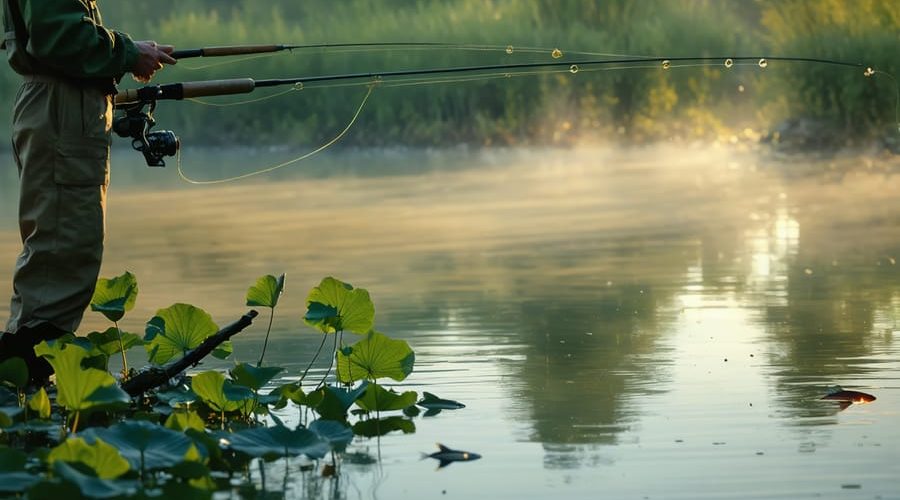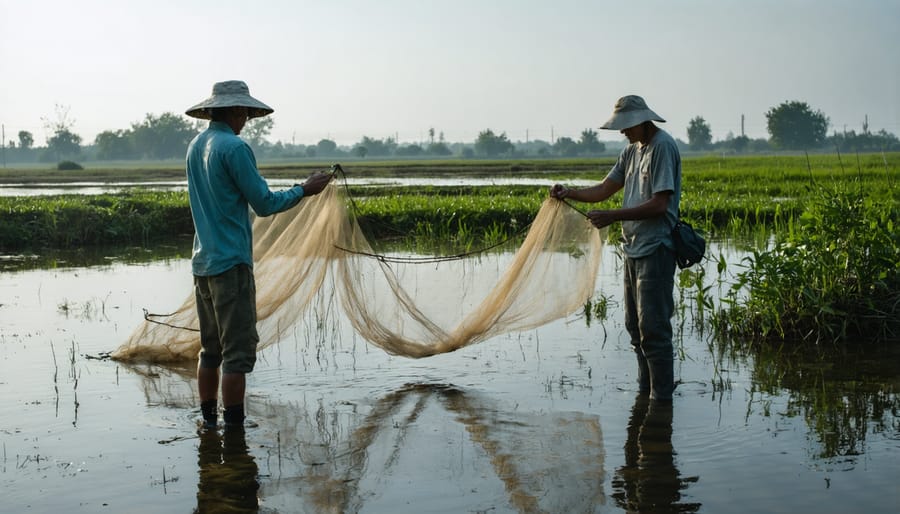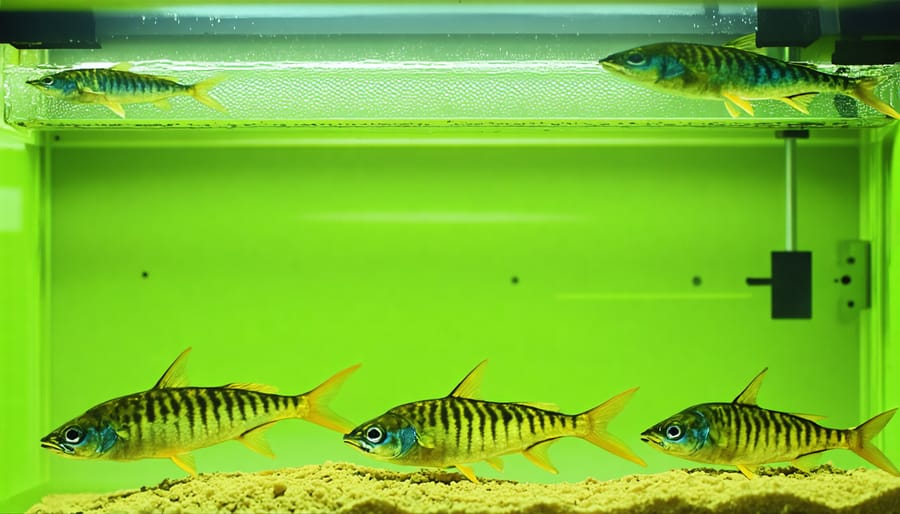
Master These Simple Pond Fishing Methods for Better Fish Breeding Success
Position yourself strategically at dawn or dusk when pond fish are most active, keeping your shadow off the water to avoid spooking them. Deploy small, lightweight gear – 4-6 pound test line and size 6-10 hooks – perfect for the confined spaces and cautious fish typical in pond environments. Master the art of gentle presentations, whether you’re working a small jig near structure or floating bread crust for surface feeders. These proven techniques not only increase your catch rate but also protect fish health, essential for successful fish breeding in managed ponds. Focus your efforts around natural gathering spots – fallen branches, lily pads, and deeper holes where fish congregate for safety and feeding opportunities.
Essential Equipment for Pond Fish Collection
Net Selection and Usage
When fishing in a pond, selecting the right net is crucial for both fish safety and successful catches. Landing nets are perfect for catching individual fish, featuring soft mesh that prevents scale damage. For larger harvests, seine nets are invaluable – these long, rectangular nets can be drawn through the water to collect multiple fish at once.
A dip net works well for smaller ponds, allowing you to quickly scoop up fish near the surface. For selective catching, telescopic nets give you the reach needed to target specific fish without disturbing others. Keep mesh sizes appropriate to your fish – too large, and smaller fish slip through; too small, and you’ll struggle with water flow.
Always ensure your nets are clean and dry between uses to prevent cross-contamination. For delicate ornamental fish like koi, use rubber-coated nets that minimize stress and protect their scales. When handling breeding fish, opt for deeper nets that provide adequate water depth during transport.

Handling Tools and Safety Gear
When pond fishing, having the right tools and safety gear is crucial for both you and the fish. Start with a long-handled net featuring soft, knotless mesh to prevent damage to fish scales. Keep a clean bucket or holding container filled with pond water nearby for temporary fish storage.
Essential safety items include non-slip waterproof boots, especially around slippery pond edges, and polarized sunglasses to reduce glare and better spot fish. For handling fish, wear shoulder-length waterproof gloves to protect against bacteria and maintain fish slime coating.
Always keep basic first aid supplies handy, including antiseptic wipes and bandages. A fish handling mat or wet towel provides a safe surface for brief examinations. Remember to sanitize all equipment before and after use to prevent cross-contamination and disease spread between different areas of your pond.
For night fishing, keep a waterproof flashlight and reflective gear nearby for visibility and safety.
Gentle Capture Methods
Seine Netting Technique
Seine netting is a traditional and effective method for collecting fish from your pond. To get started, you’ll need a seine net (typically 4-6 feet in height) and a helper, as this is definitely a two-person job. Begin by positioning yourselves at opposite ends of the pond, each holding one end of the net. Keep the bottom edge of the net weighted and touching the pond floor while maintaining the top edge above water.
Walk slowly toward each other, creating a gradual U-shape with the net. As you move, gently sweep the net through the water, being careful not to stir up too much sediment. When you meet, carefully pull both ends of the net toward the shore, maintaining the U-shape to prevent fish from escaping underneath.
Once near the shore, lift the bottom of the net slightly to create a basket effect, trapping the fish within. Gradually raise the net, keeping it taut to prevent fish from jumping out. Have a holding tank with pond water ready nearby. Quickly but carefully transfer the captured fish into the holding tank using a soft mesh net.
Remember to handle fish gently and keep them in water as much as possible. Avoid seine netting during spawning seasons or extreme temperatures. After finishing, rinse your net thoroughly and allow it to dry completely before storage to prevent damage and extend its lifespan.

Hand Net Applications
Hand nets are essential tools for pond fishing, particularly when you need to handle fish gently for breeding or health checks. When selecting a hand net, opt for one with a soft, knotless mesh to prevent damage to the fish’s scales and protective slime coating. The net should be deep enough to safely contain the fish but not so deep that it becomes unwieldy.
Timing is crucial when using a hand net. The best moments for netting fish are during feeding times when they’re more likely to be near the surface and less wary of movement. Early morning or evening hours, when fish are typically more active, also provide ideal opportunities for successful netting.
To use a hand net effectively, approach the fish slowly from behind to avoid startling them. Position the net slightly below the water’s surface and at an angle that allows you to scoop upward and forward in one smooth motion. If you’re targeting a specific fish, try to guide it toward the net rather than chasing it, which can cause stress and make capture more difficult.
Always keep the net in the water until you’re ready to lift the fish out, and have your holding container ready nearby. When transferring fish, keep them submerged as much as possible to minimize stress and prevent injury. After use, rinse your net thoroughly and allow it to dry completely before storage to maintain hygiene and prevent cross-contamination.
Sorting and Selection Process
Size Grading
Size grading is an essential step in pond fishing, particularly when managing fish populations and maintaining healthy breeding groups. The most common method involves using grading boxes or nets with specific mesh sizes to sort fish effectively. Start with the largest mesh size first to separate the biggest fish, then progressively work down to smaller mesh sizes.
For manual grading, handle fish gently in water-filled containers with different-sized gaps between parallel bars. Fish that can swim through represent the smaller grade, while those that cannot pass through move to the larger grade. This process helps maintain uniform size groups, which is crucial for reducing competition and preventing larger fish from dominating feeding areas.
Digital fish measuring boards and weight-based sorting systems offer more precise grading for commercial operations, but simple measuring tapes work well for hobbyists. Always keep fish in water during the grading process to minimize stress. Sort during cooler morning hours when fish are less active, and work quickly to return them to the pond. Remember to sanitize all grading equipment before and after use to prevent the spread of diseases between different fish groups.

Health Assessment
When collecting fish, it’s crucial to perform quick visual health assessments to ensure you’re working with healthy specimens. Start by observing the fish’s swimming behavior – healthy fish move smoothly and maintain good balance. Look for clear, bright eyes and intact fins without any tears or damage. The fish’s scales should be smooth and well-aligned, without any missing patches or obvious injuries.
As part of proper fish health management, check for any signs of parasites, unusual spots, or growths on the body. The gills should appear red or pink, not pale or discolored. Watch out for fish that appear lethargic, swim erratically, or gasp at the surface, as these could indicate health issues.
During collection, also note if the fish shows normal breathing patterns and responds alertly to movement around the pond. If you spot any concerning signs, it’s best to avoid collecting that particular fish and make a note to monitor it more closely. Remember, selecting healthy fish is crucial for successful breeding and maintaining the overall wellbeing of your pond population.
Post-Collection Care
Once you’ve successfully collected your fish, proper handling is crucial for their health and survival. Start by using a soft, wet net to minimize stress and protect their protective slime coating. Transfer the fish quickly but gently into a prepared holding container filled with pond water – this helps maintain water temperature and chemistry they’re accustomed to.
Keep the holding container in a shaded area to prevent temperature fluctuations, and ensure it’s well-oxygenated using an air stone or portable aerator. If you’re moving multiple fish, avoid overcrowding and maintain proper fish stocking density even in temporary containers.
Monitor your collected fish closely for the first 30 minutes, watching for signs of stress like rapid gill movement or erratic swimming. If you need to transport fish to another location, use sturdy, clean containers with secure lids. Add pond water and minimize air space to reduce water sloshing during transport.
For breeding purposes, separate males and females into different containers if necessary, and maintain water quality by avoiding feeding for several hours before and after collection. If you notice any injured fish, place them in a separate recovery container with a mild salt solution (1 tablespoon per 5 gallons) to help prevent infection.
Remember to clean and sanitize all equipment after use to prevent the spread of diseases between different pond environments. Return any unused fish to their original habitat promptly, following the same gentle handling procedures used during collection.
Mastering pond fishing techniques requires patience, practice, and proper understanding of both the environment and your equipment. By following the guidelines we’ve discussed – from selecting the right gear to understanding fish behavior and seasonal patterns – you’ll be well-equipped to improve your success rate at the pond. Remember that successful pond fishing isn’t just about catching fish; it’s about developing a sustainable approach that respects the ecosystem while maximizing your enjoyment of the sport.
Pay special attention to your presentation techniques, as these often make the difference between a successful day and going home empty-handed. Keep your movements subtle, maintain awareness of your shadow, and always approach spots quietly. Whether you’re using artificial lures or live bait, proper technique will consistently lead to better results.
Most importantly, stay observant and adaptable. Every pond has its unique characteristics, and the techniques that work in one location might need adjustment in another. With time and experience, you’ll develop an intuitive understanding of what works best in different situations, making each fishing session more rewarding than the last.
